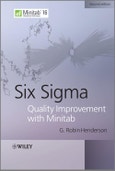The second edition includes the following new material:
- Pareto charts and Cause-and-Effect diagrams
- Time-weighted control charts cumulative sum (CUSUM) and exponentially weighted moving average (EWMA)
- Multivariate control charts
- Acceptance sampling by attributes and variables (not provided in Release 14)
- Tests of association using the chi-square distribution
- Logistic regression
- Taguchi experimental designs
Table of Contents
Foreword.Preface.
Acknowledgements.
About the Author.
1 Introduction.
1.1 Quality and Quality Improvement.
1.2 Six Sigma Quality Improvement.
1.3 The Six Sigma Roadmap and DMAIC.
1.4 The Role of Statistical Methods in Six Sigma.
1.5 Minitab and its Role in the Implementation of Statistical Methods.
1.6 Exercises and Follow-Up Activities.
2 Data Display, Summary and Manipulation.
2.1 The Run Chart – a First Minitab Session.
2.1.1 Input of Data Via Keyboard and Creation of a Run Chart in Minitab.
2.1.2 Minitab Projects and Their Components.
2.2 Display and Summary of Univariate Data.
2.2.1 Histogram and Distribution.
2.2.2 Shape of a Distribution.
2.2.3 Location.
2.2.4 Variability.
2.3 Data Input, Output, Manipulation and Management.
2.3.1 Data Input and Output.
2.3.2 Stacking and Unstacking of Data; Changing Data Type and Coding.
2.3.3 Case Study Demonstrating Ranking, Sorting and Extraction of Information from Date/Time Data.
2.4 Exercises and Follow-Up Activities.
3 Exploratory Data Analysis, Display and Summary of Multivariate Data.
3.1 Exploratory Data Analysis.
3.1.1 Stem-and-Leaf Displays.
3.1.2 Outliers and Outlier Detection.
3.1.3 Boxplots.
3.1.4 Brushing.
3.2 Display and Summary of Bivariate and Multivariate Data.
3.2.1 Bivariate Data – Scatterplots and Marginal Plots.
3.2.2 Covariance and Correlation.
3.2.3 Multivariate Data – Matrix Plots.
3.2.4 Multi-Vari Charts.
3.3 Other Displays.
3.3.1 Pareto Charts.
3.3.2 Cause-and-Effect Diagrams.
3.4 Exercises and Follow-Up Activities.
4 Statistical Models.
4.1 Fundamentals of Probability.
4.1.1 Concept and Notation.
4.1.2 Rules for Probabilities.
4.2 Probability Distributions for Counts and Measurements.
4.2.1 Binomial Distribution.
4.2.2 Poisson Distribution.
4.2.3 Normal (Gaussian) Distribution.
4.3 Distribution of Means and Proportions.
4.3.1 Two Preliminary Results.
4.3.2 Distribution of the Sample Mean.
4.3.3 Distribution of the Sample Proportion.
4.4 Multivariate Normal Distribution.
4.5 Statistical Models Applied to Acceptance Sampling.
4.5.1 Acceptance Sampling by Attributes.
4.5.2 Acceptance Sampling by Variables.
4.6 Exercises and Follow-Up Activities.
5 Control Charts.
5.1 Shewhart Charts for Measurement Data.
5.1.1 I and MR Charts for Individual Measurements.
5.1.2 Tests for Evidence of Special Cause Variation on Shewhart Charts.
5.1.3 Xbar and R Charts for Samples (Subgroups) of Measurements.
5.2 Shewhart Charts for Attribute Data.
5.2.1 P Chart for Proportion Nonconforming.
5.2.2 NP Chart for Number Nonconforming.
5.2.3 C Chart for Count of Nonconformities.
5.2.4 U Chart for Nonconformities Per Unit.
5.2.5 Funnel Plots.
5.3 Time-Weighted Control Charts.
5.3.1 Moving Averages and their Applications.
5.3.2 Exponentially Weighted Moving Average Control Charts.
5.3.3 Cumulative Sum Control Charts.
5.4 Process Adjustment.
5.4.1 Process Tampering.
5.4.2 Autocorrelated Data and Process Feedback Adjustment.
5.5 Multivariate Control Charts.
5.6 Exercises and Follow-Up Activities.
6 Process Capability Analysis.
6.1 Process Capability.
6.1.1 Process Capability Analysis with Measurement Data.
6.1.2 Process Capability Indices and Sigma Quality Levels.
6.1.3 Process Capability Analysis with Nonnormal Data.
6.1.4 Tolerance Intervals.
6.1.5 Process Capability Analysis with Attribute Data.
6.2 Exercises and Follow-Up Activities.
7 Process Experimentation with a Single Factor.
7.1 Fundamentals of Hypothesis Testing.
7.2 Tests and Confidence Intervals for the Comparison of Means and Proportions with a Standard.
7.2.1 Tests Based on the Standard Normal Distribution – z-Tests.
7.2.2 Tests Based on the Student t-Distribution – t-Tests.
7.2.3 Tests for Proportions.
7.2.4 Nonparametric Sign and Wilcoxon Tests.
7.3 Tests and Confidence Intervals for the Comparison of Two Means or Two Proportions.
7.3.1 Two-Sample t-Tests.
7.3.2 Tests for Two Proportions.
7.3.3 Nonparametric Mann–Whitney Test.
7.4 The Analysis of Paired Data – t-Tests and Sign Tests.
7.5 Experiments with a Single Factor Having More Than Two Levels.
7.5.1 Design and Analysis of a Single-Factor Experiment.
7.5.2 The Fixed Effects Model.
7.5.3 The Random Effects Model.
7.5.4 The Nonparametric Kruskal–Wallis Test.
7.6 Blocking in Single-Factor Experiments.
7.7 Experiments with a Single Factor, with More Than Two Levels, where the Response is a Proportion.
7.8 Tests for Equality of Variances.
7.9 Exercises and Follow-Up Activities.
8 Process Experimentation with Two or More Factors.
8.1 General Factorial Experiments.
8.1.1 Creation of a General Factorial Experimental Design.
8.1.2 Display and Analysis of Data from a General Factorial Experiment.
8.1.3 The Fixed Effects Model, Comparisons.
8.1.4 The Random Effects Model, Components of Variance.
8.2 Full Factorial Experiments in the 2k Series.
8.2.1 22 Factorial Experimental Designs, Display and Analysis of Data.
8.2.2 Models and Associated Displays.
8.2.3 Examples of 23 and 24 Experiments, the Use of Pareto and Normal Probability Plots of Effects.
8.3 Fractional Factorial Experiments in the 2k-p Series.
8.3.1 Introduction to Fractional Factorial Experiments, Confounding and Resolution.
8.3.2 Case Study Examples.
8.4 Taguchi Experimental Designs.
8.5 Exercises and Follow-Up Activities.
9 Evaluation of Measurement Processes.
9.1 Measurement Process Concepts.
9.1.1 Bias, Linearity, Repeatability and Reproducibility.
9.1.2 Inadequate Measurement Units.
9.2 Gauge Repeatability and Reproducibility Studies.
9.3 Comparison of Measurement Systems.
9.4 Attribute Scenarios.
9.5 Exercises and Follow-Up Activities.
10 Regression and Model Building.
10.1 Regression with a Single Predictor Variable.
10.2 Multiple Regression.
10.3 Response Surface Methods.
10.4 Categorical Data and Logistic Regression.
10.4.1 Tests of Association Using the Chi-Square Distribution.
10.4.2 Binary Logistic Regression.
10.5 Exercises and Follow-Up Activities.
11 Learning More and Further Minitab.
11.1 Learning More about Minitab and Obtaining Help.
11.1.1 Meet Minitab.
11.1.2 Help.
11.1.3 StatGuide.
11.1.4 Tutorials.
11.1.5 Assistant.
11.1.6 Glossary, Methods and Formulas.
11.1.7 Minitab on the Web and Knowledgebase/FAQ.
11.2 Macros.
11.2.1 Minitab Session Commands.
11.2.2 Global and Local Minitab Macros.
11.3 Further Features of Minitab.
11.4 Quality Companion.
11.5 Postscript.
Appendix 1.
Appendix 2.
Appendix 3.
Appendix 4.
References.
Index.








